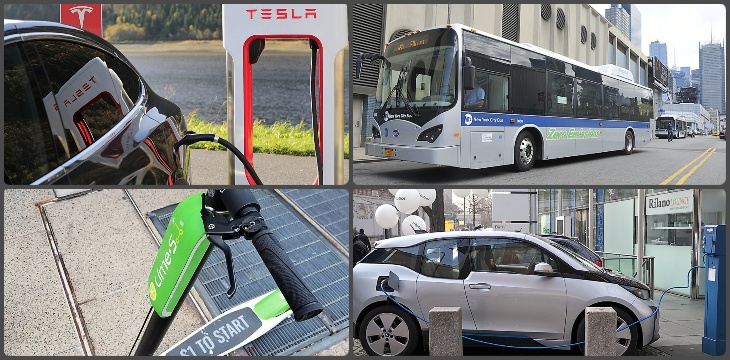
Photos by Marc A. Hermann / MTA New York City Transit and Janitors, used under this Creative Commons license; and by BeyondDC, used under this Creative Commons license.
The federal government may be getting ready to freeze emissions standards in place for conventional cars and trucks, but electric vehicles (EVs) are still on the rise. No longer the stuff of science fiction movies, but not yet commonplace, EVs have yet to fully take off in the mass market. But recent news shows that production of EVs is reaching scale, states are starting to build out the charging infrastructure needed to support a mass market, and even electric scooters are running up impressive numbers, not to mention electric buses. Here is the latest from the front lines of transportation electrification.
The media follow every twist and turn of Tesla, but perhaps the most significant Tesla news to date is that the company recently passed 200,000 car deliveries. While 200,000 may seem relatively small compared to the 253 million trucks and cars on the road in the U.S., it is a critical milestone in EV production, and indication of more to come.
AEE member Tesla may be the de facto measuring stick for EVs, but there is much more to the electrification revolution than Tesla alone. Seemingly every car manufacturer is getting ready to introduce EVs across their model lines. In fact, Green Car Reports is calling 2019 “the year of the electric SUV,” with electric sport utility models from Mercedes (EQ), BMW (iX3), SF Motors (SF7), and Volvo (XC30) scheduled to go on sale next year.
And while officials in Washington, D.C., take aim not only at auto emission standards but California’s right to set its own standards – including its mandate for EV sales – there is a push by individual states to develop the proper infrastructure for the increasing number of vehicles that need to recharge rather than refuel. For instance, California, New York, and New Jersey are putting $1.3 billion toward the development of charging infrastructure to support EV drivers. Morning Consult notes that California, Oregon, and Washington have already created a West Coast Electric Highway network, with fast-charging stations every 25 to 50 miles, while eight states in the west signed an agreement last year to develop an Intermountain West EV-charging corridor.
At the same time, new business models for EV charging continue to be explored. Adweek recently ran an article on Volta, a company that plans to use an ad-supported business model to provide EV charging for free, which just raised $35 million in Series C funding. Both public officials and private entrepreneurs are betting that the EV revolution is not around the corner, but rather pulling into the driveway.
Further evidence: USA Today highlighted a survey from AAA that found “20% of Americans say their next vehicle will be an electric car,” a number that would translate into at least 50 million EVs on the road and the highest recorded percentage of Americans who want an EV. And then there are the New York electric utilities, which are looking to help customers make that EV choice in their next purchase, with National Grid and Con Edison providing total-cost-of-ownership comparisons between similar electric and conventional models, thanks to Enervee, an AEE member company.
In addition to passenger cars, electrification is coming to vehicles big and small. Electric scooters, electric neighborhood carts, electric bikes, and electric buses are also on the road cleanly — and quietly — transporting people through many major American cities. Lime, an electric dockless scooter and bike company (not to be confused with energy efficiency company Lime Energy, an AEE member), recently passed six million rides.
And then there are transit buses, a market segment that is electrifying faster than personal vehicles. Electric buses now make up 10% of annual transit bus sales, with AEE members BYD and Proterra featured prominently in this market. Some 80% of municipal transit buses worldwide will be electric by 2040, according to Bloomberg New Energy Finance, and California is getting ready to set a 100% zero-emission goal for its transit fleets by the same date. But electric buses promise cleaner air and quieter streets in cities around the country, no matter the mix of power they draw on. Greentech Media recently reported on a study by the Union of Concerned Scientists showing that electric buses are responsible for lower carbon emissions than diesel buses even in states with an unfavorable power mix; based on the average U.S. power mix, electric buses put out half the emissions of diesel or natural gas models, according to the study.
Electric vehicles may not be the dominant force on the road today, but there are signs that America could be in the midst of another transportation revolution.
